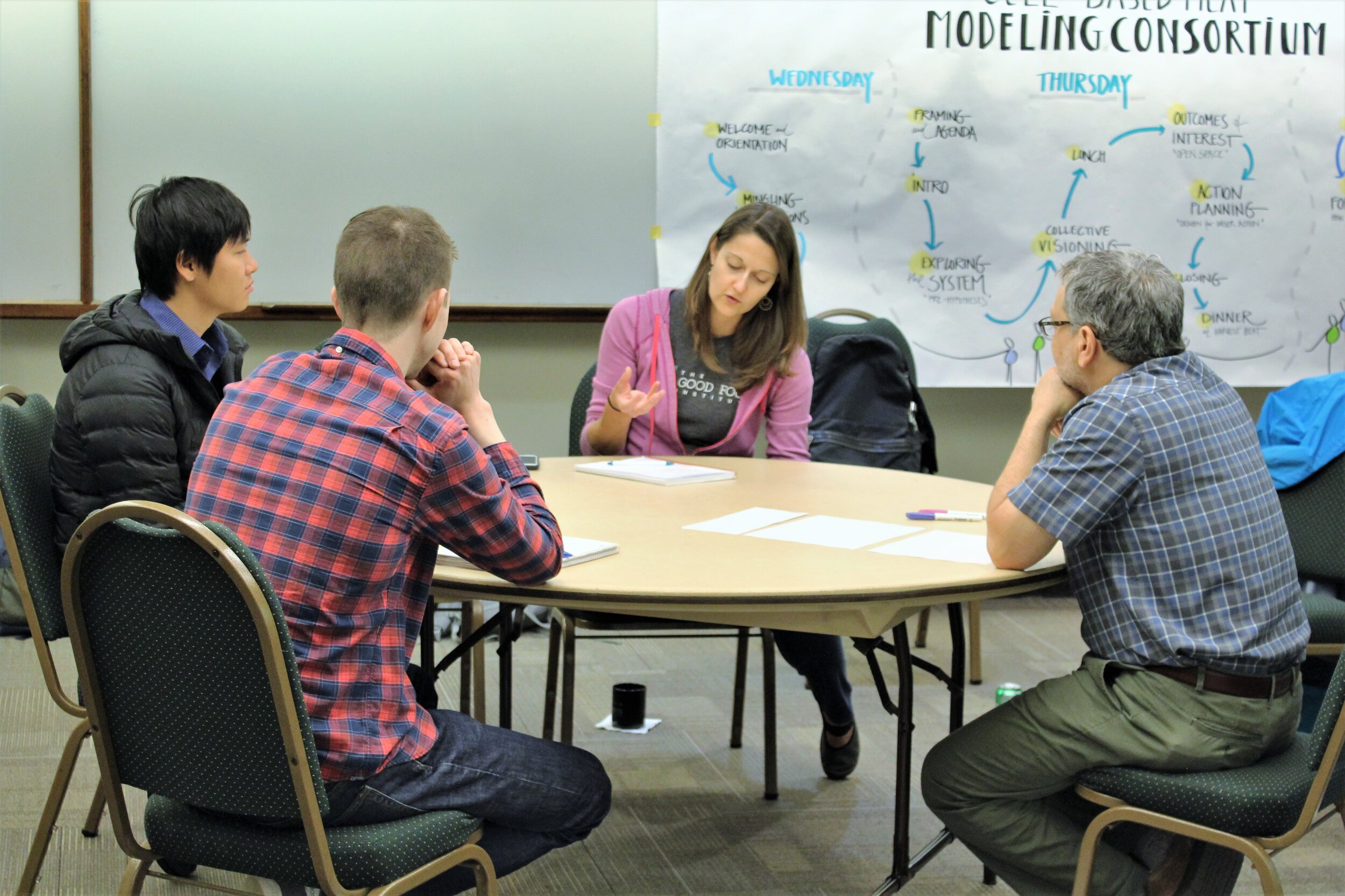Optimizing Bioreactor Conditions for the Cultivated Meat Industry
Excerpted from: Modeling the Integration of Flow, Cell and Microcarrier Biomechanics in a Bioreactor.
[Full article under preparation]
Authors: Boris Aguilar, Jiajia Chen, Chris Clark, Simon Kahan, Greg Potter
Sponsor: Merck KGaA, Darmstadt, Germany
Cultivated, or lab-grown, meat, poultry and seafood promises to provide a more humane and eco-friendly alternative to current farming practices which are a major contributor to climate change. Unlike the plant-based meat substitutes available today, cultivated meat has the potential to provide an indistinguishable replacement for ground meat and boneless fillets, disrupting what is forecasted by Grandview Research, Inc. to become a $7.3 trillion market by 2025.
A key challenge for producing cultivated meat is that kilograms of biomass must be efficiently created from just a few cells removed from a live animal as a biopsy or initiated from a cell line. The process used to produce massive quantities of cells is typically carried out in a specialized tank called a bioreactor – the same technology used to grow the specialized cells that produce many types of biologic drugs.
Bioreactor Basics
For cells to thrive in a bioreactor, they require a source of nutrients (referred to as “cell culture media” or simply “media”) and a homogeneous, oxygen-rich environment; at the same time, waste secretions from the cells must be removed or neutralized. In an animal, the transport of nutrients, oxygen and waste is achieved through blood flow; in a bioreactor, it is achieved by keeping the cells and fluid in motion using spinners or impellers or by percolating media through the vessel. Some types of meat cells must attach to something rigid before they will divide. In the bioreactor, tiny, mobile spheres called microcarriers serve this purpose, providing attachment points for these adherent cells and enabling their proliferation.
Just as human cells are sensitive to conditions in the body, cultivated meat cells are quite sensitive to the bioreactor environment. Changes in media, oxygen concentration or pH can cause a cell to differentiate into any number of cell types or even die. For this reason, the media must be precisely formulated and well-mixed. Cells are also highly sensitive to shear stress – the experience of having one side of the cell tugged relative to the other side. Turbulent flow in the bioreactor creates eddies that can exert shear stress on a cell, slowing its growth, causing it to detach from the microcarrier or, in extreme cases, killing it.
Wanted: Economies of Scale
To compete with conventional meat, kilograms of cells must be produced in bioreactors at a cost of just a few dollars per kilogram. This calls for an economy of scale, which means larger and more productive bioreactors. To maintain well-mixed media in a large tank requires that the fluid be moved faster and with more force than in a smaller tank. Unfortunately, this faster fluid flow tends to create more turbulence, which translates into more stress upon the cells.
Design innovation in bioreactors is needed to overcome this problem and achieve production at scale. Innovation requires experimentation, but experimentation is slow and expensive, requiring numerous physical prototypes and lab experiments to optimize. In contrast to this time- and labor-intensive approach, computer simulations offer the opportunity to accelerate and reduce the cost of innovation for the cultivated meat industry. Before computer simulations can be applied to cultivated meat challenges, however, new modeling methodologies are needed.
Modeling Complexity
Bioreactors are complex environments and modeling their fluid dynamics and mixing is challenging. Complicating the modeling effort is the need to capture how adherent cells grow on microcarriers while continuously consuming nutrients, excreting waste, proliferating and maintaining viability. In addition, in a stirred tank bioreactor, the production process involves starting and stopping the impeller and adding or removing fluid or microcarriers to the ongoing experiment, making the system even more complex.
Given this challenge, a successful model must be capable of accounting for changes happening at diverse system levels and time scales. Clearly, a new methodology was required to design a model capable of handling so much complexity and informing a computer simulation that would allow key questions to be answered. Key questions relevant to growing adherent cells in a stirred tank system include:
Bioreactor tank and rotor: What rotor and tank geometries result in fluid flow that maintains adequate mixing to deliver nutrients and oxygen to all cells while minimizing the stress on these cells that causes them to differentiate, quiesce or die?
Microcarriers: What size, shape and density of microcarriers would similarly optimize conditions for growth?
Bioprocess: Changing rotor speed, adding additional microcarriers, adjusting oxygen and nutrient influx are some of the bioprocess parameters that can be modulated over time. What schedule optimizes conditions for growth?
Scale: How can the tanks, rotors, microcarriers and the bioprocess be optimized for large-capacity bioreactors?
Below, we describe our approach to modeling the stirred tank bioreactor and results from our proof-of-concept studies. Ultimately, our goal is to create a foundational computational model that is widely applicable across bioreactor designs. Once a base model is established, it should be easily extended to other bioreactor systems and allow for iterative refinement at far lower cost than redesigning and testing a physical bioreactor. Computational models can also predict how the system will behave in the future and should be a significantly less expensive and time-efficient alternative to building out large-scale prototypes. In this way, modeling techniques can be developed to mirror experiments at high fidelity and should help physical experiments realize maximal efficiencies. These qualities should allow designers and users of cultivated meat bioreactors to realize cost-effective production of biomass sooner.
Model Development
In any new modeling endeavor “starting simple” has merit, as the principle promises high return in learning relative to the investment of effort. Similarly, testing a new methodology on well-studied systems provides reliable feedback on its efficacy and confidence as the methodology emerges from consistently accurate predictions.
In general, stirred tank reactors are very well-studied, and the simplest version is a stir-rod bioreactor without any control systems. With this in mind, we turned to a 1987 research paper that provided both empirical and theoretical analyses of hydrodynamic effects on microcarrier cultures in a stir-rod bioreactor.[i] The paper showed a decrease in biomass at a higher agitation speed. By reconstructing this simple bioreactor geometry and the microcarrier-bound cells in computer models, we set out to show that the model could qualitatively recapitulate these results – that at higher rotor speed (rpm), biomass production rate drops and there is a change in production rate as microcarriers saturate.
We incorporated two approaches – agent-based modeling (ABM) and computational fluid dynamics (CFD) – to model how cells move and grow in bioreactors and how the fluid forces influence cell proliferation. Neither ABM or CFD alone could adequately answer the questions raised by scientists and engineers tasked with achieving the cost reductions necessary for cultivated meat. While CFD and ABM have never been used together to understand the process dynamics within a bioreactor, they have been successfully combined in other models for disaster response, cell and particle migration through blood vessels and movement of zooplankton in complex flow environments.
CFD uses numerical analysis and data structures to analyze and solve fluid flow problems. For cultivated meat production, CFD can be used to simulate and understand the fluid flows in bioreactors which are governed by three fundamental physical principles: 1) mass conservation, 2) F = ma (Newton’s second law) and 3) energy conservation.
ABM was used to model the biological processes and interactions that determine cell behavior. In simplified terms, ABM helps make sense of interacting, autonomous “agents” which have behaviors and interact with other agents, which in turn influence their behaviors. By modeling agents individually, their contribution to the system can be understood. A 3D agent-based model of cells growing on microcarriers and moving in the fluid media of the stirred tank was created. In the ABM formulation, each cell and microcarrier is represented as a spherical agent, which is moving in a velocity field that represents the fluid media. By including the cells and microcarriers, the model allows us to study the relationships between mechanical interactions and important biological processes such as cell proliferation and cell death.
As shown in Figure 1, higher shear stress and lower Kolmogorov length (a measure of turbulence) were observed around the tips of the bioreactor impellers, indicating more potential damage to the attachment of cells on microcarriers in these regions. The bioreactor run at 240 rpm had much higher shear stress and lower Kolmogorov length than the one run at 60 rpm, indicating that a rotational speed of 240 rpm may result in more cell damage throughout the whole bioreactor.
Figure 1. Computational fluid dynamic simulations at 60RPM and 240RPM.
Using ABM, we simulated how cells grow and proliferate on a microcarrier under the assumption of zero flow conditions and abundant nutrients. These simulations are important to calibrate some of the parameters of the model and to observe how a cell is behaving on a microcarrier in a microenvironment composed of neighboring cells. Figure 2A is a simulation of cells growing on a single microcarrier. The color of the cells represents the computed mechanical stress and suggests a high variability in the mechanical stress sensed by the cells on the microcarrier. Figure 2B shows a histogram of the mechanical stress. Most of the cells experience a positive mechanical stress which indicates that they are under compressive forces due to neighboring agents.
Figure 2. ABM of cells growing on a microcarrier (A). The color indicates mechanical stress, red for compressive stress and blue for tension stress. Histogram of mechanical stress sensed by the cells growing on the microcarrier (B).
We also performed simulations of cell proliferation at impeller rotations of 60 and 240 rpm to test if the model can recapitulate the trends observed experimentally in which increasing the impeller rotation rate decreased the growth rate of cells in the bioreactor. The model, in qualitative accordance with published experimental observations, predicted that increasing the impeller velocity from 60 rpm to 240 rpm led to a decreased rate of cell proliferation.
What Lies Ahead?
As a foundational tool, this model represents a platform from which many disparate streams of inquiry can now be investigated. The next phase of the proof-of-concept involves engaging additional industry stakeholders to identify and further develop those streams which have the greatest potential to accelerate the whole industry. Ultimately, the models would facilitate optimization of bioreactor design and processes in much the same way computer-aided design and manufacturing has transformed automotive, aerospace, electronics and other industries.
Sound exciting? Join us!
In its pursuit of helping high-quality, affordable cultivated meat products reach consumers sooner, CMMC relies on diverse stakeholders including both individual engineers, scientists, entrepreneurs as well as mission-aligned companies and organizations. Contact us to learn more about membership!
[i] Croughan, M.S., Hamel, J.F., and Wang, D.I. (1987). Hydrodynamic effects on animal cells grown in microcarrier cultures. Biotechnol Bioeng 29, 130-141.








